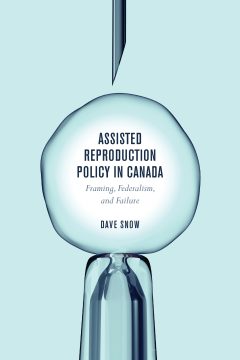In 2012 RCMP raided a small office in Brighton, Ont. and hauled away hard drives and files. Leia Picard, owner of Canadian Fertility Consulting Co., faced ten years in the penitentiary on fifteen charges under the Assisted Human Reproduction Act. It was a felony to offer any “consideration” to a surrogate mother.
“The end result was anticlimactic,” writes Professor David Snow of the University of Guelph’s Department of Political Science. Prosecutors later struck a plea deal and Picard paid a $60,000 fine. She remains the only Canadian in history charged under the Act. It was “bewildering,” said Picard’s lawyer.
“This book surveys the ruins to explain how Canada arrived at a point that nearly every policymaker and stakeholder involved in the process would describe as suboptimal,” says the author.
Assisted Reproduction Policy In Canada is meticulously researched. Professor Snow is a punchy writer. More importantly, Snow’s book is a handy guide that explains why longtime politicians glance at the ceiling and breathe a heavy sigh whenever someone says, “There ought to be a law!”
“Fundamentally, much of political science is concerned with answering one question: What drives politics?” writes Snow. As Assisted Reproduction shows, it is an impulse for government over-reach, a fetish for control and regulation and a mistaken suspicion that Canadian society is comprised of wolves and sheep, never far from chaos without the “dominant role” of Parliament.
Professor Snow notes the whole idea behind the Assisted Human Reproduction Act was “the impact of market forces in the area of human reproduction could, if not properly regulated, undermine important social values and ethical principles and harm people by leading to inappropriate, unethical or unsafe use of technology.”
Ms. Picard was arrested for breaching 2007 regulations under a 2004 law that followed 2000 consultations that followed failed bills introduced in 1997 and 1996 that followed a 1995 moratorium and 1994 consultations following the 1993 final report of a 1989 Royal Commission that ran to 1,275 pages and 293 recommendations – and on and on ad infinitum. It ended with a Supreme Court ruling that much of this was under provincial jurisdiction anyhow.
“What is remarkable when analyzing the policymaking process from 1993 to 2004, from the Royal Commission to the Act, is the extent to which the content and the frames remained almost entirely the same,” writes Snow. Time marched on, science advanced, society adapted. They even put a cloned sheep named Dolly on the cover of Newsweek magazine.
“There was significant normalization of assisted reproduction in the Western world over this period, including in Canada,” concludes Snow. “Yet the content and the framing strategies were almost entirely identical for the Royal Commission and the federal government.”
And that’s how Ottawa works.
By Holly Doan
Assisted Reproduction Policy in Canada: Framing, Federalism and Failure, by David Snow; University of Toronto Press; 200 pages; ISBN 9781-4875-23290; $22.46









